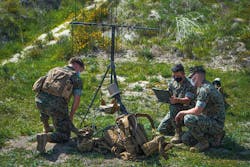CACI joins project for networking software to connect sensors and weapons in new brand of mosaic warfare
ARLINGTON, Va. – U.S. military researchers needed a company to develop fast self-healing web-like networking that connects sensors and weapons. They found their solution from CACI International Inc. in Arlington, Va.
Officials of the U.S. Defense Advanced Research Projects Agency (DARPA) in Arlington, Va., announced a 20.4 million contract to CACI-Federal last month for the for the Mission-Integrated Network Control (MINC) project.
MINC seeks to build and demonstrate software that creates a secure network overlay with control mechanisms that enable distributed management of agile, self-healing networks of networks to support multi-domain kill webs in contested dynamic environments on land, on and under the sea, in the air, in space, and in cyberspace.
CACI joins the BAE Systems Electronic Systems segment in Nashua, N.H., on the MINC program. BAE Systems won a $24.9 million MINC contract at the end of January.
The program is a vital part of mosaic warfare, which seeks to assemble individual warfighting platforms like the ceramic tiles in mosaics to make a larger intelligence picture and a larger force package. The idea will be to send so many weapons and sensors at the enemy that its forces are overwhelmed.
The MINC program seeks to ensure that critical data finds a path to the right user at the right time in contested environments using secure control of any available communications or networking resources, DARPA officials say.
This capability of connecting sensors to shooters replaces the manual, static configuration of individual, tactical networks and limited internetworking capabilities.
MINC will culminate in this paradigm shift from static manual configuration of closed rigid architectures by moving towards autonomous approaches where applications and networks adapt to changing military conditions.
The MINC program does not intend to develop any new communications and network resource hardware, but rather will develop the network and communications systems algorithms and software to configure and control available resources opportunistically.
The MINC program will address three key challenges tactical networks face today as they operate in extreme networking environments: the lack of network interoperability across heterogeneous communications systems at scale; insufficient network capacity to support missions; and the inability to reconfigure networks autonomously to align with military missions.
The project seeks to develop on-demand connectivity between sensor-to-shooter networks by focusing on three key capabilities: developing an always-on network overlay to access available networking and communications resources and control parameters; using a cross-network approach for managing network configuration; and creating ways to determine the best information flows for kill web services.
MINC seeks to capitalize on networking advances in software-defined networking; network function virtualization for decoupling network functions from hardware; information-centric networking to discover and retrieve data securely; and intent-driven networking for autonomous mapping of user objectives to network management policies.
For more information contact CACI online at www.caci.com, or DARPA at www.darpa.mil.
About the Author
John Keller
Editor-in-Chief
John Keller is the Editor-in-Chief, Military & Aerospace Electronics Magazine--provides extensive coverage and analysis of enabling electronics and optoelectronic technologies in military, space and commercial aviation applications. John has been a member of the Military & Aerospace Electronics staff since 1989 and chief editor since 1995.
